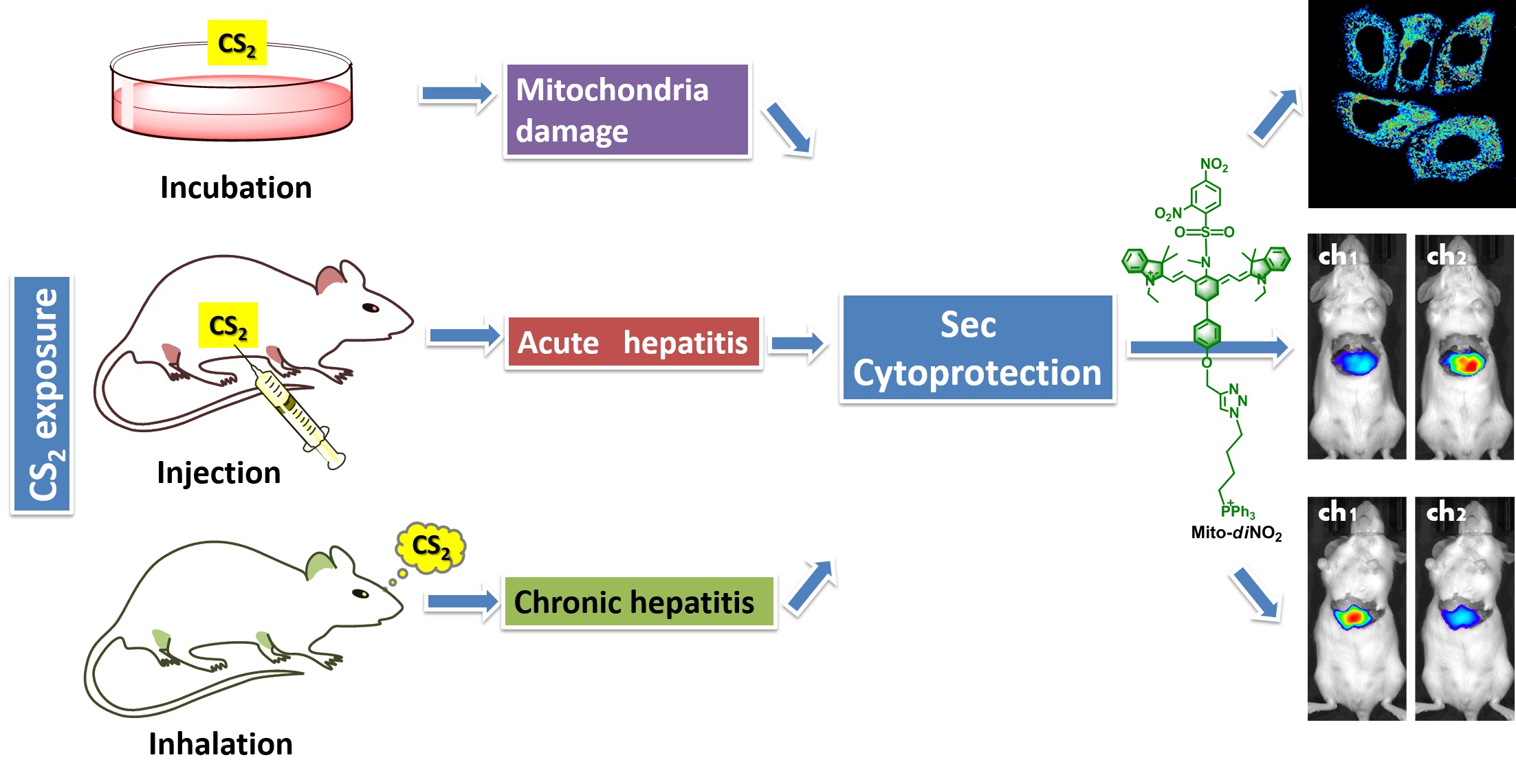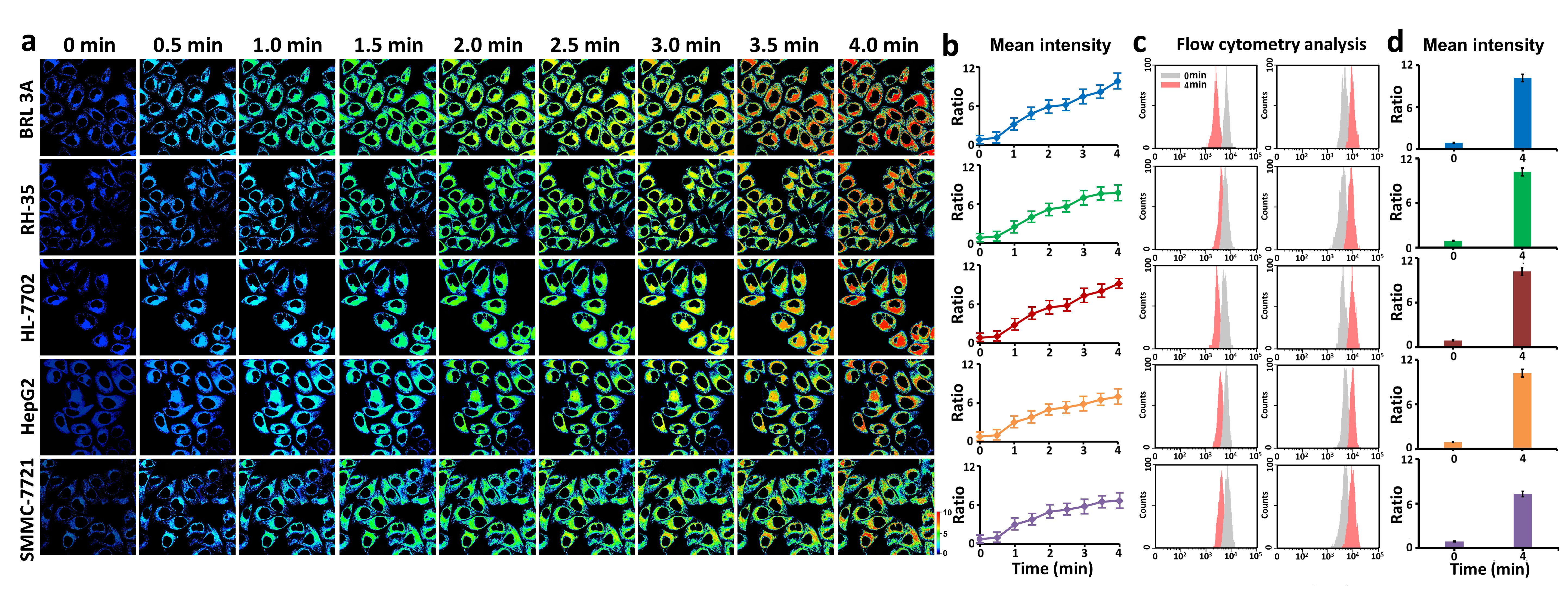博文
Evaluation selenocysteine effect by ratiometric NIR probe
|
Evaluation Selenocysteine Protective Effect in Carbon Disulfide Induced Hepatitis with a Mitochondrial Targeting Ratiometric Near-Infrared Fluorescent Probe
Xiaoyue Han,【韩潇玥】 Rui Wang,【王蕊】 Xinyu Song,【宋新宇】 Fabiao Yu*【于法标】 and Lingxin Chen*【陈令新】
Anal. Chem., Article ASAP, DOI: 10.1021/acs.analchem.8b01306, Publication Date (Web): June 4, 2018
https://pubs.acs.org/doi/10.1021/acs.analchem.8b01306
中文简讯
文章链接:http://www.x-mol.com/news/13940
文章链接: https://mp.weixin.qq.com/s/NlcfUPrjZgZZ_8OLbtHrpA
ABSTRACT: As important active sites of oxidoreductase in mitochondria, selenocysteine (Sec) takes the responsibility for cytoprotective effect and intracellular redox homeostasis. Carbon disulfide (CS2) is a common solvent in industry, which can inhibit the activities of oxidoreductase and induce oxidative stress. It is necessary to investigate the cytoprotective effect of Sec against CS2 exposure. After integrated the response moiety 2,4-dinitrobenzenesulfonamide and mitochondrial targeting moiety into the near-infrared heptamethine cyanine fluorophore, we develop a mitochondrial-targeting ratiometric near-infrared fluorescent probe Mito-diNO2 for the selective and sensitive detection of Sec level changes in cells and in mice models under the stimulation of CS2. The probe can well accumulate in mitochondria and selectively detect the concentrations of endogenous Sec in BRL 3A, RH-35, HL-7702, HepG2 and SMMC-7721 cell lines. The results indicate that CS2 exposure can lead to decrease of Sec level and result in mitochondrial related acute inflammation. The exogenous supplement of Sec can protect cells from oxidative damage and reduce the symptoms of inflammation. We also establish CS2 induced acute and chronic hepatitis mice models to examine the tissue toxicity of CS2 and cytoprotection of Sec in liver. The organism can increase the concentration of Sec to deal with the damage caused by CS2 in acute hepatitis mice model. And the exogenous supplement of Sec for the two mice models can effectively defend the CS2 induced liver damage. The real-time imaging of Sec concentrations in liver can be used to assess the degrees of liver injury during CS2 poisoning. The above applications make our probe a potential candidate for the clinical accurate diagnosis and treatment of CS2 poisoning.

� �
�
Figure 2. Quantitative application of Mito-diNO2 to endogenous Sec generation in living BRL-3A, BH-35, HL-7702, HepG2, and SMMC-7721 cells by confocal imaging and flow cytometry analysis. (a) Pseudo-colour ratio images of endogenous Sec generation in BRL-3A, BH-35, HL-7702, HepG2, and SMMC-7721 cells at different time points: 0 min, 0.5 min, 1.0 min, 1.5 min, 2.0 min, 2.5 min 3.0 min, 3.5 min, and 4.0 min by confocal laser-scanning microscope with an objective lens (× 40). Fluorescence collection windows for channel 1: 770 – 800 nm (λex = 730 nm), channel 2: 650 – 750 nm (λex = 635 nm). (b) Plots of average ratio intensities of Mito-diNO2 against time. Cell number n = 7. (c) Flow cytometry analysis and (d) corresponding mean ratio intensities at time points: 0 min and 4.0 min. The experiments were repeated three times and the data were shown as mean (± s.d.).
�
Figure 3. Evaluation the relationship between Sec concentration and mitochondrial related acute inflammation in SMMC-7721 cells. The cell were incubated with 10 μM (Sec)2 for 24 h, or 1 μM CS2 for 6 h, or 10 μM (Sec)2 for 24 h before the treatment of 1 μM CS2 for 6 h, respectively. Mito-diNO2 (10 μM) was added for 4 min at 37oC before confocal imaging and flow cytometry analysis. (a) Pseudo-color ratio images of Sec concentration. (b) Flow cytometry analysis for quantitative application. (c) The ratio of mean ratio fluorescence intensities in (a). and (d) The ratio of mean fluorescence intensities of two different detection channels in (b). (e) Western blotting analysis of p-ERK (phospho-ERK), p-p38 (phospho-p38), p-JNK (phospho-JNK), p-NF-κB p65 (phospho-NF-κB p65), and TNF-α. Relative molecular mass is indicated on the left. β-actin was used as a loading control. (f) Scheme of CS2 induced mitochondrial related inflammation signal transduction pathways. (g) A statistical analysis of p-ERK protein expression. (h) A statistical analysis of p-p38 protein expression. (i) A statistical analysis of p-JNK protein expression. (j) A statistical analysis of p-NF-κB p65 protein expression. (k) A statistical analysis of TNF-α protein expression. The data were shown as mean (± s.d.) (n = 7). Difference was analyzed by one-way ANOVA and Bonferroni post-test. ØP < 0.05, ØØP < 0.01 or ØØØP < 0.001 vs control group.
�
Figure 5. Evaluation of Sec in acute/chronic hepatitis mice models and therapy mice models. a) In vivo imaging: Group a: control; Group b: CS2 induced 6 h acute hepatitis BALB/c mice; Group c: CS2 induced 12 h acute hepatitis BALB/c mice; Group d: CS2 induced 18 h acute hepatitis BALB/c mice; Group e: CS2 induced 24 h acute hepatitis BALB/c mice; Group f: CS2 induced 1 month chronic hepatitis BALB/c mice; Group g: CS2 induced 2 months chronic hepatitis BALB/c mice; Group h: CS2 induced 3 months chronic hepatitis BALB/c mice; Group i: CS2 induced 4 months chronic hepatitis BALB/c mice; Group j – n were pre-treated with 500 μg/kg (Sec)2 (i.p.) in PBS qd for 8 weeks before the same treatment of Group a – i. Group o – r were pre-treated with 500 μg/kg (Sec)2 (i.p.) in PBS qd for 8 weeks. And then 500 μg/kg (Sec)2 (i.p.) in PBS was continued to be given daily before the inhalation of 5% CS2 (at air flow rate with 40 mL/min for 1 h, qd) for 1 month, 2 months, 3 months, and 4 months, respectively. Mito-diNO2 (10 μM, 50 μL, in 1:99 DMSO/saline, v/v) was injected into liver through portal vein for 15 min before imaging. b) TUNEL staining of liver sections. Scale bar: 100 μm. c) TEM observation. Scale bar: 1 μm. d) Representative slides of Masson-stained liver tissues. Scale bar: 100 μm. e) Representative slides of H&E-stained liver tissues. Scale bar: 100 μm. f) ALT levels in serum. g) AST levels in serum. h) ALB levels in serum. i) GLB levels in serum. j) TBIL levels in serum. k) ALP levels in serum. l) GGT levels in serum. m) LDH levels in serum. The data were shown as mean (± s.d.) (n = 7).
https://blog.sciencenet.cn/blog-2438823-1119512.html
上一篇:unique NIR cyanine probe for imaging of alkaline phosphatase
下一篇:Detection MOAB enzyme and its oxidative stress by NIR probe
全部作者的其他最新博文
- • Engineered extracellular vesicles: an emerging nanomedicine
- • β-galactosidase activated probe for cellular senescence
- • 动态氢调控纳米通道智能驱动氢释放新策略实现糖尿病创面高效修复
- • Near-infrared II fluorescent probe for lung metastatic tumor
- • Metabolic Acidity/H2O2 Dual-Cascade Activatable Probe
- • Mitochondrial Fluorescent Probe for Hypochlorite and Sulfur